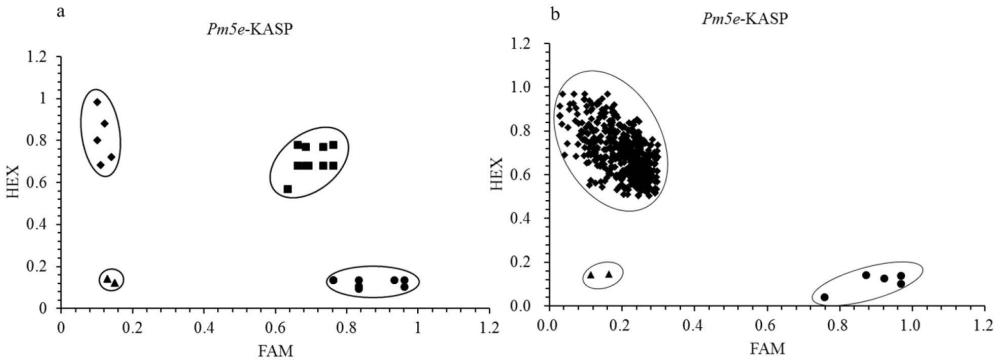与小麦抗白粉病基因pmHYM共分离的KASP标记、引物及应用

本发明涉及与小麦抗白粉病基因pmhym共分离的kasp标记、引物及应用,可应用于分子标记辅助育种,属于农业生物。
背景技术:
1、在生产中小麦不断面临着各种真菌病害的威胁,包括赤霉病、锈病、纹枯病和由布氏小麦白粉菌引起的白粉病。白粉病的爆发一般会造成10%至15%的小麦产量损失,在严重流行病年份,其损失可能超过50%(juroszek和von tiedemann,2012,climate changeand potential future risks through wheat diseases:a review,eur j plant pathol136:21–33)。小麦抗病品种的选育与种植是众多防治白粉菌中最为经济环保的防治措施。然而,具有单一抗性基因的抗性品种的大面积利用可能会导致新的毒性小种的出现。因此,为了在不使用杀菌剂等可能破坏环境或者不健康等因素的考虑下,不断发掘和利用新的抗白粉病基因至关重要。
2、迄今,已报道有140多个小麦抗白粉病基因/数量性状基因座(qtl),其中包括83个正式命名的基因和59个临时命名的基因遍布所有小麦染色体上(wang等,2023,fightingwheat powdery mildew:from genes to fields,theor appl genet 136:196)。然而,其中存在重复或错误使用某些基因/qtl的情况。例如pm1-pm5和pm24基因座,包含多个等位基因(xu等,2020,mapping powdery mildew resistance gene pmybl on chromosome 7b ofchinese wheat(triticum aestivum l.)landrace youbailan,plant dis 104:2411-2417)。然而,这些等位基因并不全是正确的,其中一些被认为是新等位基因的材料实际上包含相同序列的等位基因,如pm2(chen等,2019,positional cloning of pmch1357reveals the origin and 305allelic variation of the pm2 gene for powderymildew resistance in wheat,the crop journal 7:771-783)、pm5(xie等,2017,finemapping of powdery mildew resistance gene pmtm4 in wheat using comparativegenomics,journal of integrative agriculture 16:540-550)和pm24(lu等,2017,wheatpm55 alleles exhibit distinct interactions with an inhibitor to causedifferent powdery mildew resistance,nat commun 15:503)。随着各种分子生物学技术的发展,已经克隆了15个抗白粉病基因,包括pm1(hewitt等,2021,a highlydifferentiated region of wheat chromosome 7al encodes a pm1a immune receptorthat recognizes its corresponding avrpm1a effector from blumeria graminis,newphytol229:2812-2826)、pm2a(sánchez-martín等,2016,rapid gene isolation inbarley and wheat by mutant chromosome sequencing,genome biol 17:221)、多个pm3等位基因(yahiaooui等,2006,rapid generation of new powdery mildew resistancegenes after wheat domestication,plant j 47:85-98)、pm4b(sánchez-martín等,2021,wheat pm4 resistance to powdery mildew is controlled by alternative splicevariants encoding chimeric proteins,nat plants 7:327-341),pm5e(xie等,2020,arare single nucleotide variant in pm5e confers powdery mildew resistance incommon wheat,new phytol 228:1011-1026)、pm8(hurni等,2013,rye pm8 and wheat pm3are orthologous genes and show evolutionary conservation of resistancefunction against powdery mildew,plant j 76:957-969)、pm12(zhu等,2023,orthologous genes pm12 and pm21 from two wild relatives of wheat showevolutionary conservation but divergent powdery mildew resistance,plantcommun4:100472)、pm17(singh等,2018,evolutionary divergence of the rye pm17 andpm8 resistance genes reveals ancient diversity,plant mol biol 98:249-260)、pm21(he等,2018,pm21,encoding a typical cc-nbs-lrr protein,confers broad-spectrum resistance to wheat powdery mildew disease.mol plant 11:879-882;xing等,2018,pm21 from haynaldia villosa encodes a cc-nbs-lrr protein conferringpowdery mildew resistance in wheat.mol plant 11:874-878)、pm24(lu等,2020,arare gain of function mutation in a wheat tandem kinase confers resistance topowdery mildew,nat commun 11:680)、pm38(krattinger等,2009,a putative abctransporter confers durable resistance to multiple fungal pathogens inwheat.science 323:1360-1363)、pm41(li等,2020,a cnl protein in wild emmer wheatconfers powdery mildew resistance,new phytol 228:1027-1037)。除了pm4b、pm24、pm38和pm46,其他克隆的基因都属于cnl类抗病基因。
3、在最近的一项研究中,研究者通过基于图谱的克隆分离出pm5e。该基因编码具有不完整cc结构域、nb结构域和lrr结构域的nlr类蛋白(xie等,2020,arare singlenucleotide variant in pm5e confers powdery mildew resistance in common wheat,new phytol 228:1011-1026)。有意思的事,pm5d、pmh、pmbyyt、pmtm4、mlxbd和mlmz的序列都与pm5e的序列相同,另外还发现16个小麦地方品种携带该基因。此外,两个显性基因pmdgm(wu等,2021,characterization of pmdgm conferring powdery mildewresistance in chinese wheat landrace duanganmang,plant disease 105:3127-3133)和pmal11(han等,2023,identification of a wheat powdery mildew dominantresistance gene in the pm5 locus for high-throughput marker-assistedselection,plant dis 107:450-456)也携带该基因。携带相同基因,但是抗谱不同,而且基因的显/隐性也不相同,这些机制还有待继续研究。因此,本研究是从红蚰麦中克隆pmhym,并开发诊断性分子标记将其转移到优异小麦品种上,以便育种利用。
4、随着各种测序技术的不断进步,分子标记的种类也日益多样化。早期的限制性片段长度多态性(restriction fragment length polymorphism,rflp)和扩增片段长度多态性(amplified fragment length polymorphism,aflp)等标记已经不能够满足当下高通量试验的需求。随着基因组测序技术的不断发展,新型的分子标记如简单重复序列(simplesequence repeats,ssr)、序列标签位点(sequence tagged sites,sts)、酶切扩增多态性序列(cleaved amplified polymorphic sequence,caps)、衍生的酶切扩增多态性序列(derived cleaved amplified polymorphic sequence,dcaps)、单核苷酸多态性(singlenucleotide-acid polymorphism,snp)、内含子标签(intron targeting,it)和保守直系同源基因序列(coserved ortholog sequence,cos)等也应运而生。这些丰富种类的分子标记将在作物重要性状的定位、基因克隆和其他方面发挥更为重要的作用。然而,上述大多数类型的标记在pcr程序之后仍然需要借助琼脂糖凝胶等电泳技术进行检测分型。基于荧光集团分型的kasp标记具有快速、高通量及准确等天然优势,本研究开发的pmhym诊断性的竞争性等位基因特异性聚合酶链式反应标记(kompetitive allele specific pcr,kasp)将为该基因的快速育种利用奠定基础。
技术实现思路
1、本发明针对上述研究背景,以高抗白粉病小麦品种红蚰麦为抗病材料筛选和寻找新的而且稳定存在与白粉病抗性基因紧密连锁的分子标记及其方法,用于小麦白粉病辅助选择育种,能够克服常规遗传育种周期长等缺点。
2、本发明提供的技术方案如下:
3、本发明提供与小麦抗白粉病基因pmhym共分离的kasp标记,所述分子标记位于小麦7b染色体,所述kasp标记的序列如seq id no.1所示;所述seq id no.1的竞争性引物第22位碱基处为t或c;所述kasp标记的基因型为tt基因型的小麦是抗白粉病小麦品种;所述kasp标记的基因型为cc基因型的小麦是感白粉病小麦品种。
4、本发明还提供与小麦抗白粉病基因pmhym紧密连锁的分子标记引物,该引物是与小麦白粉病抗性基因pmhym共分离的kasp标记xmp1394的引物,标记xmp1394与目标基因共分离,引物序列如下:
5、竞争性引物:
6、1)5’-gaaggtgaccaagttcatgcttgctagcatttacagctttgctt-3’,
7、2)5’-gaaggtcggagtcaacggatttgctagcatttacagctttgctc-3’;
8、共同引物:5’-ggcgaacgtcaacaacagg-3’。
9、本发明还提供上述的与小麦抗白粉病基因pmhym共分离的kasp标记或上述的引物在鉴定小麦白粉病抗性中的应用。
10、本发明还提供一种小麦白粉病抗性的鉴定方法,采用上述引物检测小麦dna样本中是否存在抗白粉病基因pmhym,若存在,则表明待测小麦具有高白粉病抗性。
11、一种小麦白粉病抗性的鉴定方法,采用上述的引物对待测小麦的dna进行检测,若pcr产物出现xmp1394标记的fam荧光的pcr产物,则表明待测小麦具有高白粉病抗性。
12、进一步的,所述方法包括以下步骤:
13、(a)提取待测样本dna;
14、(b)用检测引物对进行pcr扩增;
15、(c)对pcr产物进行荧光检测与分析。
16、进一步的,以红蚰麦或其他携带pmhym的品种为对象,用上述与小麦白粉病抗性基因pmhym共分离的kasp标记xmp1394的引物pcr扩增小麦植株dna,如果出现xmp1394标记的fam荧光的pcr产物,则表示该植株中小麦白粉病的抗性基因存在。
17、pcr反应体系5μl:内含模板50~100ng、左引物各12μm、右引物30μm、2.5μl的2×kasp master mix(lgc genomics);
18、反应循环程序如下:94℃预变性15min,后按“94℃,20s;65℃,60s”10个循环(每个循环降低0.5℃),接着按“94℃,20s;60℃,60s”35个循环,在37℃,60s的步骤后读取kasp数据。利用lightcycler480的1.5.1.62版本的软件进行荧光数据的分析与可视化。
19、有益效果
20、白粉病是影响小麦生产的一种严重病害,本发明利用分子标记方法开发出一个新的与白粉病抗性基因pmhym共分离的kasp标记,在小麦育种实践和抗病理论研究上都有很重要的价值。其优点包括:
21、本发明中与小麦抗白粉病基因紧密连锁的kasp标记,是对地方品种红蚰麦及其抗性稳定的杂交后代单株中获得的新标记,可以用于小麦白粉病品种鉴定和小麦抗病后代的辅助选择育种。
22、本研究是从红蚰麦中克隆pmhym,并开发诊断性分子标记将其转移到优异小麦品种上,以便育种利用。该标记为稳定的kasp标记,并且与抗白粉病基因共分离。可直接用于小麦抗白粉病分子标记的辅助选择育种,加快育种进程。
- 还没有人留言评论。精彩留言会获得点赞!